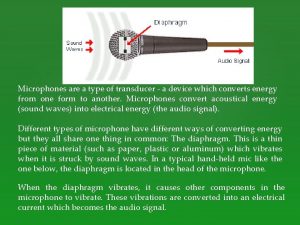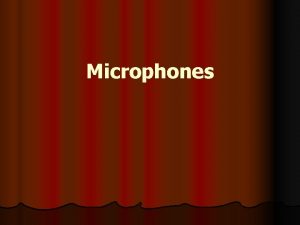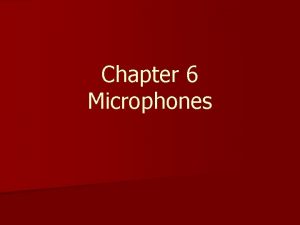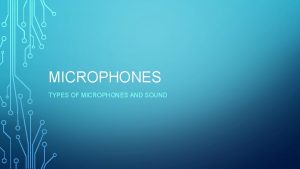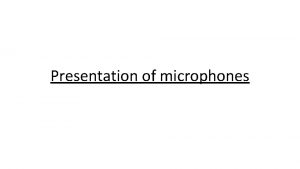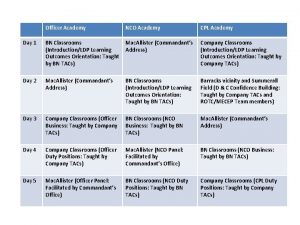Microphones National 5Higher Music Technology Kincorth Academy Microphones




























- Slides: 28

Microphones National 5/Higher Music Technology Kincorth Academy

Microphones Transducer – a device which turns one form of energy into another. Microphones are transducer, as are speakers. A microphone is the opposite of a speaker and, to some extend, can be substituted for eachother.

Which microphones to choose: Before you select a microphone you need to know : ¡ The main types of microphones (Dynamic and Condenser) Condenser and how they are used. ¡ The pick up patterns : the directions from which a microphone can pick up sound. ¡ Frequency response: How good a microphone is at picking up different ranges of pitch. ¡ Sensitivity: How well a microphone will pick up quiet sounds

2 Main Microphone types ¡ Dynamic : a microphone that generates it own power. ¡ Condenser: A microphone that has an electrical charge therefore needs to be supplied with power. They are also known as Capacitor microphones.

Dynamic Microphones Dynamic microphones are designed around a very basic principle. They contain a diaphragm attached to a metal coil. As sound waves make the diaphragm vibrate, the coil moves rapidly in the magnetic field. This makes electricity flow in the wires, producing a small electrical signal.

Dynamic Microphones

Advantages of using Dynamic Microphones ¡ Cheap to produce ¡ Robust ¡ Able to cope with high level signals

Disadvantages of using Dynamic Microphones ¡ Limited frequency response (not as wide as our ears!)

Condenser Microphones Condenser microphones use a different technique to convert the sound wave into a current. Put simply; two charged plates are held close to one another, if the distance between them changes (e. g. vibration) the charge will change too. Condenser microphones require phantom power. Phantom power is a method that sends a DC electric power through microphone cables to operate microphones that contain active electronic circuitry.

Condenser Microphones

Advantages of Condenser Microphones ¡ Wide flat frequency response – can be used for almost anything.

Disadvantages of using Condenser Microphones ¡ Delicate (easily broken) ¡ Expensive!

Polar Patterns ¡ Microphones are all different and pick up sounds or Vibrations from different directions. ¡ Some microphones pick up sounds from any direction, other pick up from the sounds source. i. e. the front/ rear/sides ¡ The Pattern of direction is called the polar pattern of the Microphone.

Some of the most common polar patterns ¡ Cardoid ¡ Omni directional ¡ Figure of eight (bi-directional) ¡ Hyper Cardoid

Cardoid Mics ¡ Picks up sound in one direction - sounds are picked up in a heart shape, mainly from the front, a little from the sides and almost nothing from the back

Omni – directional Mics ¡ Sensitive in all directions – pick up everything

Figure of eight mics ¡ Picks up in 2 directions – useful between 2 singers or drums.

Hyper Cardoid mics ¡ Mainly picks up from the front but some sounds from the back.

Microphone Selection Issues regarding microphone selection: ¡ Instrument volume ¡ Instrument frequency range ¡ Ambience or direct sound

Instrument Volume ¡ Loud instruments may damage more sensitive mics (i. e. condensers) ¡ Soft instruments may not feed a high enough signal into a less senitive mic. (i. e. dynamic)

Instrument Frequeny Range ¡ Instruments generating a high frequency range require a mic to pick up that range. (Condenser) ¡ Instruments with a more restricted frequency range don’t require a wide mic frequency response. (Dynamic)

Ambience or Direct Sound ¡ If we want to record with some ambience then we can choose either a mic polar pattern that will pick up ambience, or position the mic further from the source. ¡ If we don’t require ambience (i. e. in the studio) then we can choose a mic with a tighter polar pattern and position the mic close to the source.

Drumkit ¡ ¡ ¡ Instruments are LOUD Each instrument has a limited frequency range. Perhaps some ambience required. 2 overhead condensers pick up the greater part of the drum kit. The distance of these mics negate the worry of instrument volume Dynamic is placed in or at the bass drum to ensure a solid sound. A dynamic may also be placed at the snare.

Grand Piano ¡ ¡ Wide frequency range Not particularly loud. A matched pair of condenser mics should be used for this 2 different mic will result in an imbalance of sound.

Acoustic Guitar ¡ ¡ Instrument is quiet Wide frequency range Condenser mics are the obvious choice. By using 2 mics placed like this will give us a good stereo image.

Wind instruments ¡ ¡ Relatively low instrument volume Wide frequency range Best recorded with condenser mics. Mics should be placed at the apex of a triangle where the instrument is the bottom edge.

Brass Instruments ¡ ¡ Instruments are loud Wide frequency range Ideally condenser mics should be used to pick up the wide frequency range however, it is safer ad more practical to use dynamic mics.

Project 1 – Radio Broadcast ¡ ¡ Plan, record and edit a radio broadcast. A short broadcast along the lines of Desert Island Discs, involving an interview and music excerpts, would be suitable, but you may choose a different theme, agreed with your assessor. Your chosen theme must involve at least 5 different audio tracks, at least 2 of which must be recorded using a microphone, and there must be some creative use of sounds or music. You should now have enough information to make informed choices as to which microphones you might use and how to place them. Obviously your choices will be limited to what is available within the department
 Music music music
Music music music Directional properties of microphones
Directional properties of microphones Local guide program
Local guide program Music academy regensburg
Music academy regensburg Romantic instruments
Romantic instruments Texture refers to loudness and quietness of music
Texture refers to loudness and quietness of music What music that employs electronic music?
What music that employs electronic music? Instrument ilocano music
Instrument ilocano music Stafford academy for technology
Stafford academy for technology Columbus humanities arts and technology academy
Columbus humanities arts and technology academy Gmail
Gmail National academy for public administration
National academy for public administration National academy of statistical administration
National academy of statistical administration Railroad training school
Railroad training school National emergency services academy
National emergency services academy National coalition academy
National coalition academy National skills academy for retail
National skills academy for retail National academy of sciences forensic science
National academy of sciences forensic science Lbsnaa mess menu
Lbsnaa mess menu Music technology leaving cert
Music technology leaving cert Teaching music theory with technology
Teaching music theory with technology National music standards
National music standards Ulsan national institute of science and technology (unist)
Ulsan national institute of science and technology (unist) Assistive technology implementation plan sample
Assistive technology implementation plan sample National programme on technology enhanced learning
National programme on technology enhanced learning National institute of standards and technology
National institute of standards and technology National research university of electronic technology
National research university of electronic technology Nara images
Nara images National information technology development agency
National information technology development agency

